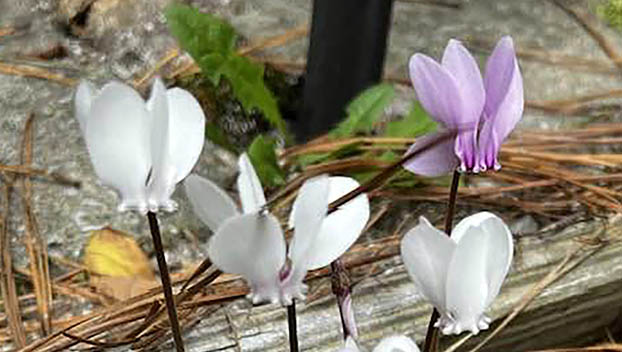Through the Garden Gate: Bulbs to select for late season blooms
Published 9:04 am Monday, November 24, 2025
It’s always good to have a few late season surprises sprinkled throughout the garden. Both red spider lilies and ivy-leaved cyclamen are interesting choices because they have interesting blooms and growth habits.
The red spider lily (lycoris radiata) is a member of the amaryllis family that was brought to the United States in the 1800s. It remains dormant all summer and then in late summer or early fall produces multiple, tall stems of bright red flowers that last for about two weeks. Strap-like foliage doesn’t appear until after the blooms are spent.
While the red spider lily isn’t difficult to grow, it doesn’t like to be disturbed once it’s been planted, so take care to choose exactly the right location. This bulb grows best in an area that receives full to partial sun and has well-drained soil that is rich in organic matter. It also doesn’t bloom well if planted too deep. In fact, about a quarter-inch of the neck (skinny top of the bulb) should protrude from the soil.

During the summer when the red spider lily is dormant, supplemental watering is generally not needed. Once the blooms buds appear, however, the soil should be kept moist. Apply fertilizer in early spring and again in late fall after blooming is complete.
The red spider lily has been a favorite of Southern gardeners for generations. They’ve not only planted it near their homes, but also on the graves of deceased relatives. Depending on where gardeners live, the red spider lily is known by various other common names: the corpse flower, the hurricane lily, the flower of death, and the spider lily.
While the red spider lily is tall and showy, the ivy-leaved cyclamen (cyclamen hederifolium) is demure and shy. It’s a low maintenance perennial that only grows four- to 12-inches tall and spreads slowly to cover about half a square foot of earth. It has white to pinkish white butterfly-shaped flowers that appear in September and October. After the blooms are spent, attractive mottled silvery gray leaves emerge and remain until spring when the plants go dormant. It’s the perfect addition to shady rock gardens or for planting underneath shrubs. It can also be naturalized in woodland areas.
The ivy-leaved cyclamen grows best in partly shady areas where there is well-drained soil rich in humus. The corms should be covered with about an inch of soil.
Both the red spider lily and the ivy-leaved cyclamen are more impactful when planted in multiples. Consider groups of three to five positioned in an irregular pattern, perhaps something similar to an isosceles triangle. The red spider lilies can be planted in fall, while the ivy-leaved cyclamen should be planted in spring. It’s easy to forget about these plants once they’re in the ground. They’ll make you smile, however, when they reappear with blooms.
DR. CYNTHIA WOOD is a local master gardener.


Comments are closed.